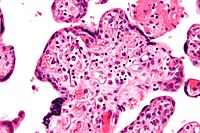
Photo from wikipedia
&NA; Placental‐related fetal growth restriction arises primarily due to deficient remodeling of the uterine spiral arteries supplying the placenta during early pregnancy. The resultant malperfusion induces cell stress within the… Click to show full abstract
&NA; Placental‐related fetal growth restriction arises primarily due to deficient remodeling of the uterine spiral arteries supplying the placenta during early pregnancy. The resultant malperfusion induces cell stress within the placental tissues, leading to selective suppression of protein synthesis and reduced cell proliferation. These effects are compounded in more severe cases by increased infarction and fibrin deposition. Consequently, there is a reduction in villous volume and surface area for maternal‐fetal exchange. Extensive dysregulation of imprinted and nonimprinted gene expression occurs, affecting placental transport, endocrine, metabolic, and immune functions. Secondary changes involving dedifferentiation of smooth muscle cells surrounding the fetal arteries within placental stem villi correlate with absent or reversed end‐diastolic umbilical artery blood flow, and with a reduction in birthweight. Many of the morphological changes, principally the intraplacental vascular lesions, can be imaged using ultrasound or magnetic resonance imaging scanning, enabling their development and progression to be followed in vivo. The changes are more severe in cases of growth restriction associated with preeclampsia compared to those with growth restriction alone, consistent with the greater degree of maternal vasculopathy reported in the former and more extensive macroscopic placental damage including infarcts, extensive fibrin deposition and microscopic villous developmental defects, atherosis of the spiral arteries, and noninfectious villitis. The higher level of stress may activate proinflammatory and apoptotic pathways within the syncytiotrophoblast, releasing factors that cause the maternal endothelial cell activation that distinguishes between the 2 conditions. Congenital anomalies of the umbilical cord and placental shape are the only placental‐related conditions that are not associated with maldevelopment of the uteroplacental circulation, and their impact on fetal growth is limited.
Journal Title: American Journal of Obstetrics and Gynecology
Year Published: 2018
Link to full text (if available)
Share on Social Media: Sign Up to like & get
recommendations!